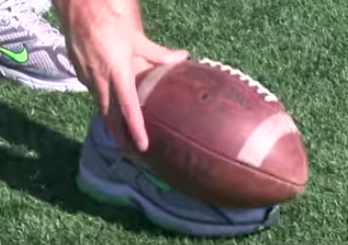Punting a spiral with a football is a significant technique for a punter to be effective. It allows the ball to travel faster and farther through the air. Punt a spiral is all about the drop and direction of the kick.
To punt a spiral, drop the football at the correct angle and lock the knee and ankle pointed straight while swinging the leg upward, which will give the football the rotation it needs to spin in a spiral.
Punting a spiral is a lot easier than you would anticipate it to be. It requires proper drop, hold, and kick technique, which can be accomplished with any size football.
Before we dive into how we kick a spiral, let’s learn about how the spiral punt came to be and the history behind the spiral punt.
Also, if you’re a high school kicker, be sure you’re practicing with a high school football for practice.
History Of The Spiral Punt
The spiral punt was invented by Alex Muffat at Princeton University.
Who’s Alex Muffat? Alex was a fascinating football player. He played tailback for the Princeton Tigers and was a standout kicker. He may not have known it then, but he revolutionized the kicking game and is widely known today as one of the greatest kickers ever.
He introduced the spiral punt, which would soon eliminate the traditional end-over-end punt used then. Not only did he invent the spiral punt, but he also introduced the dropkick to football.
What’s even more fascinating about Alex Muffat is that he was equally talented at kicking the football with both right and left legs, something we’ve yet to see in any professional leagues.
100 years later, the spiral punt still stands as the primary type for punters of all ages.
See Our Complete List Of Helpful Football Articles Here
Why Punt A Spiral?
Kicking a spiral punt is most effective because it travels the farthest and highest of the punter’s foot. Like how a quarterback throws a spiral that can zip through the air, the punter tries to execute the same technique.
There’s actually scientific evidence about how the spiral is more efficient for traveling higher and farther. Let’s take a look:
The Science Behind A Spiral Punt
The spiral on a football spins 600 times per minute. This is as fast as a CD turning in a CD player or any hard disk. This is significant because it allows the ball to fight the wind as it cuts through the air.
It actually reduces drag as it cuts through the air, almost creating a “tunnel” that it’s traveling through. When it hits its apex, gravity will start to take over, pulling the football’s nose down toward the ground.
When the ball spins in a circle, it creates gyroscopic torque, which improves its aerodynamic accuracy and flight. Balls that are punted without a spiral will have an irregular fight, limiting the hang time of the football.
Remember, the point of punting is to pin the other team deep in their zone and limit a return. A high and deep punt is the only way to do this effectively and efficiently.
Here is a great visual from Gopher Physics on how the spiral impacts the ball flight:
How To Punt A Spiral
To punt the football in a spiral, punters must execute a list of things:
- Approach
- Proper Drop
- Contact
- Follow Through
Let’s first study the approach and how your first couple of steps will impact the ball flight and trajectory.
Approach
Stand with 2 feet together or slightly staggered. You don’t want one foot completely behind the other in a sprinter stance because a bad snap will force your feet to cross over.
Also, for a high snap, it’s tougher to jump and catch or tip it off of staggered legs. If anything goes completely wrong with the snap, having your feet and upper body square to the long snapper is the best practice.
Proper Drop
This is the most important part of the punt. When we talk about the drop, we’re talking about the ball leaving the punter’s hand and the short distance it travels to the foot.
Improper drops are the biggest cause of punters’ foot, shanking it off the side of their foot or resulting in a short punt. We want to turn the ball slightly in our hands to the bend of our foot, depending on if we’re right-footed or left-footed.
The drop should leave our hands and connect with the foot with no rotation or turn of the football. This should be practiced thousands of times through the season and off-season.
This technique is the hardest to hit consistently as wind, rain, and other weather elements may affect football. Here’s a video from Ray Guy describing his punt drop:
Making Contact With The Football
Once we have the drop perfected and consistently dropping the football toward our foot with a slight turn, we need to practice making contact with the football.

Your knee and ankle should be fully locked out when making contact with the football. If the ankle isn’t locked out, it will cause the ball to hit an inconsistent area of the foot, typically resulting in a shank off the side of the foot or a bad kick in general.
Contacting the ball with the middle-outside part of our foot and pointing the toe will cause the football to fly off in a spiral.
Follow Through
We’ve established our approach, the drop is on point, and we’ve made sufficient contact – now, let’s finish the kick! The follow-through is important for generating power throughout the kick.
For example, if your leg stops when it makes contact, you’re not generating any power through the football. Similar to how a player runs a 40-yard dash, you don’t run to the 40-yard line; you run through it. It’s the same concept. Swing the leg completely through the kick, getting the punt as high and far as possible.
Impact Of Kicking A Spiral Punt
As mentioned, we want to kick a spiral punt to pin the return team as deep and as far as possible. It also gives your cover team a chance to get down the field and make a tackle, limiting a return.
Having a punter or kicker who can pin the other team in their territory without a team is a vital asset to have. Some coaches undermine special teams and kickers but rely on them the most when the game is on the line.
In the NFL, teams like the Baltimore Ravens and Los Angeles Rams are always in a great position to win because they can play stellar defense behind two great punters in Sam Koch & Johnny Hekker.
Conclusion
If you’re a punter, take pride in your punting. Great punting gives mediocre defenses a chance to win football games. Consistently keeping the ball pinned in the opponent’s territory is key.
Also, keeping the ball away from dangerous return men contributes to the height and depth punters can produce on their kicks. Practice the punting technique every single day to maximize output.
The saying goes, “Special teams are 1/3 of the game”. Punting is just as significant as a good defense or offense.
Related Q & A
Why Do Teams Punt On 4th Down?
4th down is the last down or the chance that teams have to get a first down. Instead of sacrificing valuable field position, teams will elect to punt the football to pin the opponent in their own territory. Field position is crucial in keeping opponents as far away from the end zone as possible.
Why Do Teams Punt Instead Of A Field Goal?
Football teams, especially professional teams, may choose to punt the football instead of going for a field goal. This can result from many game factors, but teams who have a strong defense and a weak offense may choose to pin their opponent deep in their territory and play good defense in hopes of getting the ball back.
What Is The Gunner Position On Punt?
The gunner position is the two players who are split the widest on the outside of the punt formation. These two positions are responsible for containing the outside and making sure the returner doesn’t get a free run down the sideline.
